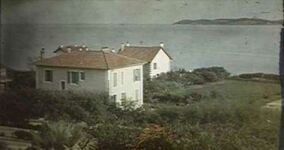Lippmann plate

Gabriel Lippmann conceived a two-step method to record and reproduce colours, variously known as direct photochromes,[1] interference photochromes,[1] Lippmann photochromes,[1] Photography in natural colours by direct exposure in the camera[1] or the Lippmann process of colour photography.[2] Lippmann won the Nobel Prize in Physics for this work in 1908.
A Lippmann plate is a clear glass plate (having no anti-halation backing), coated with an almost transparent (very low silver halide content) emulsion of extremely fine grains, typically 0.01 to 0.04 micrometres in diameter.[3] Consequently, Lippmann plates have an extremely high resolving power[4] exceeding 400 lines/mm.
Method
In Lippmann's method, a glass plate is coated with an ultra fine grain
For this method Lippmann won the Nobel Prize in Physics in 1908.[7]
The colour image can only be viewed in the reflection of a diffuse light source from the plate, making the
Other sources of Lippmann plates
- The Kodak Spectroscopic Plate Type 649-F is specified with a resolving power of 2000 lines/mm.[9]
- A diffusion method for making silver bromide based holographic recording material[10]
References
- ^ ISBN 0-486-23586-6.
- ^ US 6556992
- ^ R.W.G. Hunt, The Reproduction of Colour, 6th ed, p6
- ^ "Emulsion Definition". www.tpub.com. Archived from the original on 24 July 2010. Retrieved 12 January 2022.
- ^ "Recent developments in Lippman photography", Jean-Marc Fournier, Benjamin R. Alexander, et al.;Proc. SPIE 3358, 95 (1998)
- Bragg diffraction
- ^ "Lippmann's and Gabor's Revolutionary Approach to Imaging". nobelprize.org. Archived from the original on 2006-07-12.
- ^ Lippmann Security
- ISBN 0-87985-083-3.
- ^ Blyth, Jeff; Roger B. Millington; Andrew G. Mayes; Christopher R. Lowe, "A diffusion method for making silver bromide based holographic recording material", Institute of Biotechnology, University of Cambridge, Tennis Court Road, Cambridge, archived from the original on January 28, 2010, retrieved July 25, 2010
